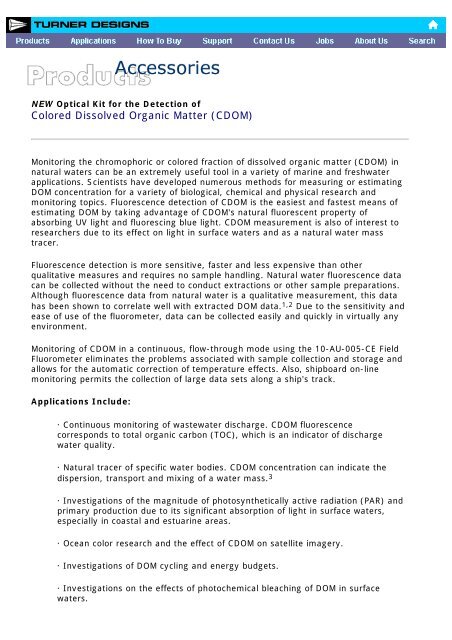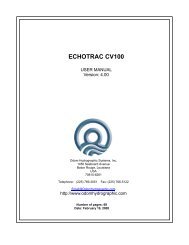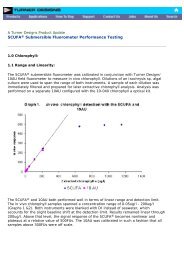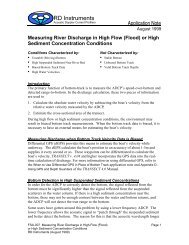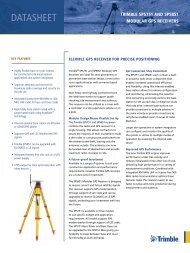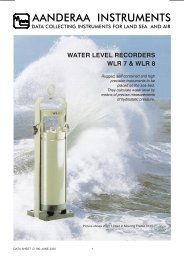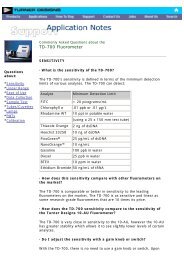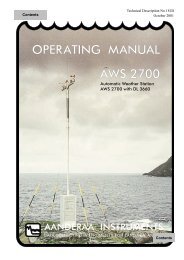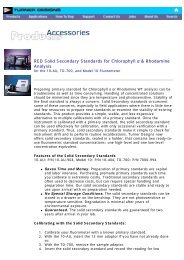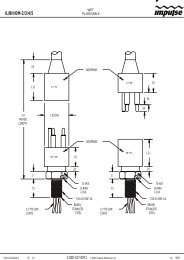Optical Kit for the Detection of
Optical Kit for the Detection of
Optical Kit for the Detection of
Create successful ePaper yourself
Turn your PDF publications into a flip-book with our unique Google optimized e-Paper software.
NEW <strong>Optical</strong> <strong>Kit</strong> <strong>for</strong> <strong>the</strong> <strong>Detection</strong> <strong>of</strong><br />
Colored Dissolved Organic Matter (CDOM)<br />
Monitoring <strong>the</strong> chromophoric or colored fraction <strong>of</strong> dissolved organic matter (CDOM) in<br />
natural waters can be an extremely useful tool in a variety <strong>of</strong> marine and freshwater<br />
applications. Scientists have developed numerous methods <strong>for</strong> measuring or estimating<br />
DOM concentration <strong>for</strong> a variety <strong>of</strong> biological, chemical and physical research and<br />
monitoring topics. Fluorescence detection <strong>of</strong> CDOM is <strong>the</strong> easiest and fastest means <strong>of</strong><br />
estimating DOM by taking advantage <strong>of</strong> CDOM's natural fluorescent property <strong>of</strong><br />
absorbing UV light and fluorescing blue light. CDOM measurement is also <strong>of</strong> interest to<br />
researchers due to its effect on light in surface waters and as a natural water mass<br />
tracer.<br />
Fluorescence detection is more sensitive, faster and less expensive than o<strong>the</strong>r<br />
qualitative measures and requires no sample handling. Natural water fluorescence data<br />
can be collected without <strong>the</strong> need to conduct extractions or o<strong>the</strong>r sample preparations.<br />
Although fluorescence data from natural water is a qualitative measurement, this data<br />
has been shown to correlate well with extracted DOM data. 1,2 Due to <strong>the</strong> sensitivity and<br />
ease <strong>of</strong> use <strong>of</strong> <strong>the</strong> fluorometer, data can be collected easily and quickly in virtually any<br />
environment.<br />
Monitoring <strong>of</strong> CDOM in a continuous, flow-through mode using <strong>the</strong> 10-AU-005-CE Field<br />
Fluorometer eliminates <strong>the</strong> problems associated with sample collection and storage and<br />
allows <strong>for</strong> <strong>the</strong> automatic correction <strong>of</strong> temperature effects. Also, shipboard on-line<br />
monitoring permits <strong>the</strong> collection <strong>of</strong> large data sets along a ship's track.<br />
Applications Include:<br />
· Continuous monitoring <strong>of</strong> wastewater discharge. CDOM fluorescence<br />
corresponds to total organic carbon (TOC), which is an indicator <strong>of</strong> discharge<br />
water quality.<br />
· Natural tracer <strong>of</strong> specific water bodies. CDOM concentration can indicate <strong>the</strong><br />
dispersion, transport and mixing <strong>of</strong> a water mass. 3<br />
· Investigations <strong>of</strong> <strong>the</strong> magnitude <strong>of</strong> photosyn<strong>the</strong>tically active radiation (PAR) and<br />
primary production due to its significant absorption <strong>of</strong> light in surface waters,<br />
especially in coastal and estuarine areas.<br />
· Ocean color research and <strong>the</strong> effect <strong>of</strong> CDOM on satellite imagery.<br />
· Investigations <strong>of</strong> DOM cycling and energy budgets.<br />
· Investigations on <strong>the</strong> effects <strong>of</strong> photochemical bleaching <strong>of</strong> DOM in surface<br />
waters.
· The use <strong>of</strong> CDOM fluorescence data to calculate <strong>the</strong> fluorescent quantum yield<br />
that is <strong>the</strong>n used to determine <strong>the</strong> CDOM absorption coefficient. 4<br />
Ordering In<strong>for</strong>mation:<br />
The CDOM <strong>Optical</strong> <strong>Kit</strong> (P/N 10-303 or 7000-960) includes two Near UV Mercury Vapor<br />
Lamps, 350nm excitation filter (310-390nm), a 410-600nm emission filter, a 1:75<br />
Attenuator plate, and a 10-300 Reference Filter (>300nm). The 10-303 <strong>Optical</strong> <strong>Kit</strong><br />
works in <strong>the</strong> 10-AU Digital Field Fluorometer and <strong>the</strong> Model 10 Analog Fluorometer and<br />
also includes a reference filter (P/N 10-300). The 7000-960 <strong>Optical</strong> <strong>Kit</strong> works in <strong>the</strong> TD-<br />
700 Laboratory Fluorometer.<br />
NOTE: For those conducting research in freshwater or estuarine systems, with potentially high DOM<br />
concentrations, <strong>the</strong> 10-318R(1:5) or 10-327R(1:75) Attenuator Plate may also be necessary to prevent<br />
samples from exceeding <strong>the</strong> dynamic range <strong>of</strong> <strong>the</strong> fluorometer.<br />
References:<br />
1) Chen, R.F. and J.L. Bada. 1992. The fluorescence <strong>of</strong> dissolved organic matter. Mar.<br />
Chem. 37:191-221<br />
2) Smart, P.L., B.L. Finlayson, W.D. Rylands, C.M. Ball. 1976. The relation <strong>of</strong><br />
fluorescence to <strong>the</strong> dissolved organic carbon in surface waters. Water Res. 10: 805-811.<br />
3) Wiley, J.D. and L.P. Atkinson. 1982. Natural fluorescence as a tracer <strong>for</strong><br />
distinguishing between Piedmont and Coastal Plain River water in <strong>the</strong> nearshore waters<br />
<strong>of</strong> Georgia and North Carolina. Estuar. Coast. Shelf Science, 14: 29-59.<br />
4) Vodacek, A., N.V. Blough, M.D. DeGrandpre, E.T. Peltzer, R.K. Nelson. 1997.<br />
Seasonal variation <strong>of</strong> CDOM and DOC in <strong>the</strong> Middle Atlantic Bight: Terrestrial inputs and<br />
photooxidation, Limnol Oceanogr. 42(4): 674-686.<br />
Turner Designs manufactures more fluorometers and research grade<br />
luminometers than any o<strong>the</strong>r company in <strong>the</strong> world.<br />
fluorometer.committed


